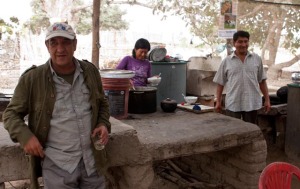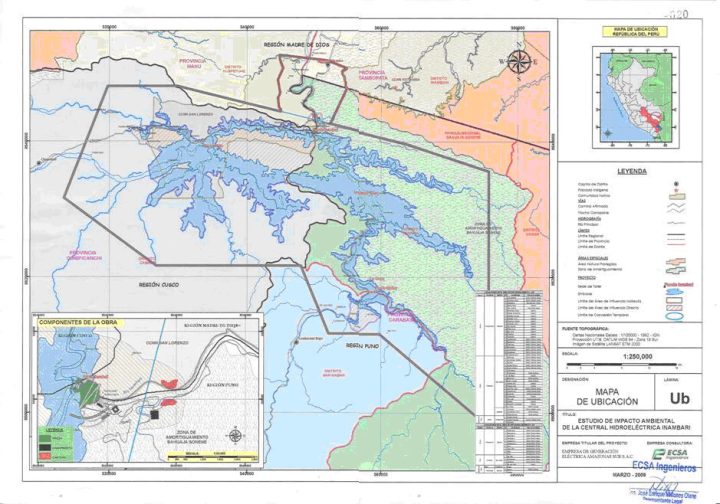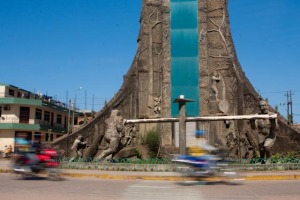Puerto Maldonado
The heat and humidity is pretty stifling getting off the plane but it feels right. How it should be. It’s the bloody jungle after all.
Bags collected, I pressed through the gang of touting mototaxistas (motor taxi drivers: three or two wheeled) and the waiting tour guides holding up the signs for their lodges. After a minute I grabbed a tuk tuk and headed off into town. Puerto Maldonado (PEM) is a jungle frontier town at the confluence of the Tambopata and the Madre de Dios rivers. It is going through big changes as a result of the Inter Oceanica Highway that is being built here. A massive carretera that stretches from the coast of Brazil to (so far) PEM. The only thing stopping it ploughing through the town is the Madre de Dios river. However, a bridge is under construction and as soon as that is completed this huge highway will tear though the town, changing it forever. It will eventually reach the coast. When it is paved the road will enable the export of Brazilian products to the Asian market, through the Peruvian ports of the Pacific. Without question, once opened, the highway will accelerate deforestation of the Amazon. You only have to look at a satellite photograph of the area to see that is it already happing. With roads come people, settlements, deforestation and hunting. Already Puerto Maldonado registers the biggest rate of annual population growth in Peru at 3.5% (Maria Emilia Coelho: FROM MUD TO ASPHALT. FROM ASPHALT TO QUAGMIRE). Hundreds of people arrive every day in Madre de Dios in search of work. Illegal gold prospecting is openly carried out in the rivers leading to potentially catastrophic poisoning of the waters as the prospectors pour in mercury to extract the gold. Illegal logging is also rife. All of these practices inevitably puts the survival of indigenous peoples at even more of a risk than it is already.
One of Fauna Forever’s flagship initiatives is Forest Corridors Forever (FCF) which is working closely with local families, communities, government and not-for-profit organisations to develop a network of forest corridors that will cross the Inter Oceanica Highway. This will link the Tambopata National Reserve to intact forested areas to the north of the highway, and thus maintain the ecological integrity of the Reserve, its wildlife and rich biodiversity. Funding for the development of these corridors and incentives for locals to protect and replant their forests will come from the promotion and sale of environmental services such as carbon, biodiversity, and water credits.
Rattling up to FFT HQ I was met by Chris Kirkby (FFT Director and Principal Investigator), Dave Johnstone (Marketing Manager) and Brian Crnobrna (Herpetology Coordinator). Later arrived Rachel Handley de Amable (Project Manager) and Naun Amable Silva (Bird Coordinator). After quick introductions we all went out for lunch at a place on the Plaza de Armas (the main square. Every Peruvian town has one) to discuss strategy. Two more days of meetings with various organisations including the Baltimore Community’s representative, Victor. FFT are in discussions with them about bringing volunteers to their community on the Rio Tambopata. We will pay them a visit soon to see the place with our own eyes and check out what could be done there. The office is very close to el obelisco (the obelisk). A concrete tower built on a roundabout that serves as a mirador or viewpoint over the town and the rivers and forest beyond. Around the base of the tower are tableaux and statues of various activities depicting various industries of the area.
FFT’s latest recruit, George Bareham arrives in Peru
 The plane landed with a jolt at 21.06, 29th April, Jorge Chavez airport, Lima. It had been an uneventful journey from London apart from the routine interrogation at immigrations in Miami where I had transited through. A couple of films, two or three not very funny sitcoms, surfing the radio, OK food, periodic strolls up and down the aisle. And so it went. After immigrations and security and through the final door in Lima I was greeted by hysterical screams from a hoard of teenage girls. My tiredness lifted suddenly until I realised that I was exiting with some Peruvian pop band which I had momentarily joined. We immediately parted (creative differences); the band into their limo and me into my cab headed for Miraflores, the posh, touristy bit of Lima by the sea.
The plane landed with a jolt at 21.06, 29th April, Jorge Chavez airport, Lima. It had been an uneventful journey from London apart from the routine interrogation at immigrations in Miami where I had transited through. A couple of films, two or three not very funny sitcoms, surfing the radio, OK food, periodic strolls up and down the aisle. And so it went. After immigrations and security and through the final door in Lima I was greeted by hysterical screams from a hoard of teenage girls. My tiredness lifted suddenly until I realised that I was exiting with some Peruvian pop band which I had momentarily joined. We immediately parted (creative differences); the band into their limo and me into my cab headed for Miraflores, the posh, touristy bit of Lima by the sea.
I hadn’t made a reservation and the place I had in mind was full which surprised me as last time I had stayed there it had been deserted. Anyway, I then tried next door at Flying Dog’s but that was also full. Now very tired, we then drove to a place in Surquillo that the cab driver had suggested. It wasn’t far so what the hell. They had a room. Basic but OK. I wasn’t in a fussy mood. After paying and thanking my driver (and paying for the room), being handed the standard issue toilet roll, soap and towel, I chucked my bags on the bed and jumped in the shower. Bloody hell I was starving I suddenly realised. The shower had revived me a bit so I was out into the night hunting for anticuchos which I had a craving for. Anticuchos are slices of beef heart on skewers and barbecued. Often found on street corners all over the country and usually delicious. They also only come out at night. A bit like vampires. Unfortunately, my luck was out that night as I couldn’t find any anywhere and I wasn’t going to walk far so I settled for some chaufa, AKA Chinese food, another Peruvian favourite. I bought a couple of beers (Cusqueñas)  went back to my room and watched a bit of TV.
went back to my room and watched a bit of TV.
As those who are familiar with such budget hotels will know, the tiny TV is often placed in a cage high up at ceiling level, so even lying on the bed you have to crane your neck to watch it properly. It didn’t really matter as I quickly fell asleep, planning tomorrow.
Next morning, after being woken up by the traffic, I was out into the day. The weather never seems to change in Lima. It is perpetually grey. Everything, or so it seems. Well, it occasionally drizzles. I’d decided to stay at my hotel for one more night as I didn’t have the energy to haul all my stuff to somewhere else and check out time was imminent. I spent most of the day slowly reacquainting myself with the capital, writing emails, changing money. You can change money in Miraflores safely with the official street changers unlike in others countries where you are likely to get ripped off.
After one more night at my lovely hotel and at last finding anticuchos (aha)!! I upped-sticks and moved to Miraflores proper after being kindly offered a spare bed by my good friends, Jan and Margot. Jan works for Peruvian Safaris and is a former manager of Explorer’s Inn. I called Chris Kirkby, now my boss as I am working for www.faunaforever.org/fft and www.fotoforever.org (as photographic workshop leader) and we all met at the Peruvian Safaris office where Max Gunther, the founder and owner of Explorer’s Inn rainforest lodge and research centre presides.
The following few days were spent in meetings with various people representing organisations who Fauna Forever could eventually work with. All interesting stuff.
Chris then had to go to Cusco so Jan had the idea of going up to stay at his friend’s finca (farm). We drove north out of Lima, following the Pan American Highway through the cool, misty desert, passing the occasional shanty towns and battery chicken barns. The finca was a friendly place. Chickens, maize, cows. A smoky kitchen at the back where people were busy preparing food over an open fire.  We all sat and had a drink of the local firewater while Jan caught up with his friend. The farm was to play host to a group of about 25 Dutch students who were coming to the end of their Grand Tour of Peru. They arrived in their bus not long after us and they set up camp on the bare ground in front of the main building. Someone dug a big hole in the ground where the food was to be cooked. After digging, large stones are placed at the bottom of the hole. Wood is then put on top and burned. Eventually when the whole thing is red hot, chicken and sweet potato, wrapped in banana leaves are put in and the hole is filled with earth. This way of cooking is known as Pachamanca. It all slow cooks perfectly, and a few hours later we all enjoyed roast chicken and sweet potatoes al fresco. Very nice it was too.
We all sat and had a drink of the local firewater while Jan caught up with his friend. The farm was to play host to a group of about 25 Dutch students who were coming to the end of their Grand Tour of Peru. They arrived in their bus not long after us and they set up camp on the bare ground in front of the main building. Someone dug a big hole in the ground where the food was to be cooked. After digging, large stones are placed at the bottom of the hole. Wood is then put on top and burned. Eventually when the whole thing is red hot, chicken and sweet potato, wrapped in banana leaves are put in and the hole is filled with earth. This way of cooking is known as Pachamanca. It all slow cooks perfectly, and a few hours later we all enjoyed roast chicken and sweet potatoes al fresco. Very nice it was too.
Next day we all set off on a desert trek to a place called Medio Mundo; an archaeological site where the remains of ancient pyramids still lie. It took about four hours across this lunar landscape. Luckily the weather was nice and cool or it might have been a bit of a nightmare. It was good to stretch the legs in such an unusual environment. That night we camped again and ate well again. 
So after these adventures it was at last time to complete my journey and head off to the rainforest!! Chris and the rest of the Fauna Forever team were already in Puerto Maldonado (PEM) so I was to meet them there. I took a pre-dawn taxi to the airport – 35 soles (pay no more) and boarded the plane as the sun was coming up. All flights from Lima to Puerto Maldonado go via Cusco. You just stay on the plane. To Cusco is about an hour. I hadn’t been able to get a direct flight so I had to get out at Cusco and collect my bags ready for a three hour ‘layover’. I rechecked my bag for PEM and went out of the airport to eat some local food. 5 soles for a big plate including refresco (juice). Bargain. I then went back into the airport and used the WiFi in the VIP lounge. They said as long as I bought a coffee that would be OK. You should try it. Mind you, the coffee cost more than twice as much as the food I had just bought.
Back on the plane I was on my way again. It’s always worth getting a window seat for the journey from Lima. When I first came here 10 years ago to be a Resident Naturalist at Explorer’s Inn (EI) I was amazed at how the landscape changes below you. Rising out of the grey blanket covering Lima, hugging the coastline, the ocean glittering, heading south, the landscape soon becomes mountainous and seemingly uninhabited. You can just make out settlements in the valleys between the snowy peaks. It’s pretty spectacular and I’d never seen anything like it before. Circling Cusco (the naval of the world according to the Incas) set out in the shape of a puma, you double-back and descend quickly. Then up and away again, everything changes even more dramatically . Mountains quickly give way to lush, green rainforest, the kind I had seen countless times on nature documentaries on TV, the kind I had yearned to see for years while in England and now I was actually here! Rivers snaked and looped below me flanked by ox-bow lakes and the green seemed to stretch to the horizon. I couldn’t believe I was actually seeing it with my own eyes. “Down there be wild Indians and jaguars and anacondas, “ to misquote Peter Matthiessen’s At Play in the Fields of the Lord. That’s what my thoughts turned to though. Down there was wildness and unimaginable adventure. What was it going to be like? So excited!!!
. Mountains quickly give way to lush, green rainforest, the kind I had seen countless times on nature documentaries on TV, the kind I had yearned to see for years while in England and now I was actually here! Rivers snaked and looped below me flanked by ox-bow lakes and the green seemed to stretch to the horizon. I couldn’t believe I was actually seeing it with my own eyes. “Down there be wild Indians and jaguars and anacondas, “ to misquote Peter Matthiessen’s At Play in the Fields of the Lord. That’s what my thoughts turned to though. Down there was wildness and unimaginable adventure. What was it going to be like? So excited!!!
Good morning and welcome to The Amazon
Welcome to a new platform for discussing the Amazon rainforest. In particular, we will be talking much about the region in Peru called Tambopata. Why Tambopata? Because this is arguably the most biologically diverse area on our planet and a good example of the ‘ups and downs’ of a typical Amazon rainforest region.
We are a registered charity in Peru; a group of dedicated scientists, artists, communication specialists, anthropologists, researchers, volunteers, writers, photographers, teachers and businessmen from many different continents, working with many organisations, working with local people, with one common goal.
Together, we want to learn about this invaluable resource and pass on the information we gather to the rest of the World in a way which is easy and interesting enough to digest happily over a morning coffee. The more minds we can put together on this platform, the more chance we will have to bring change. Together, let’s discover new ways of protecting and replanting the Amazon.
We believe that if you are reading this you will likely know the importance of the rainforest. But perhaps, you won’t feel the importance until it’s too late… or will you?
Welcome to Fauna Forever.





leave a comment